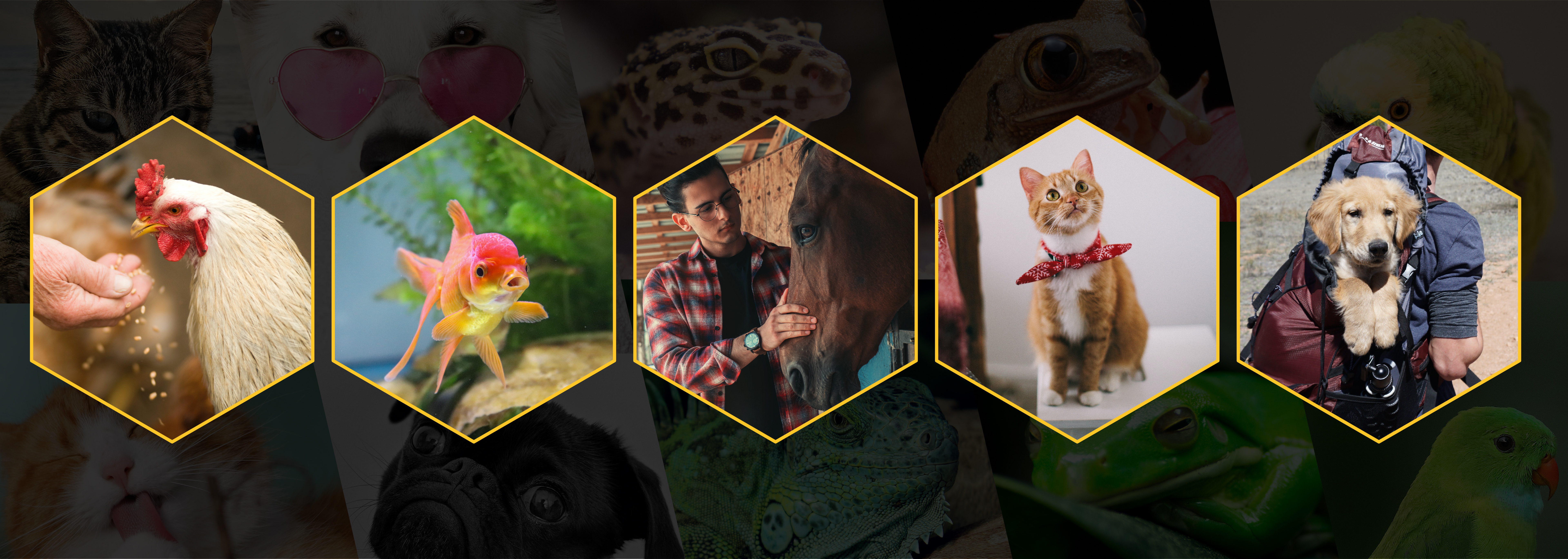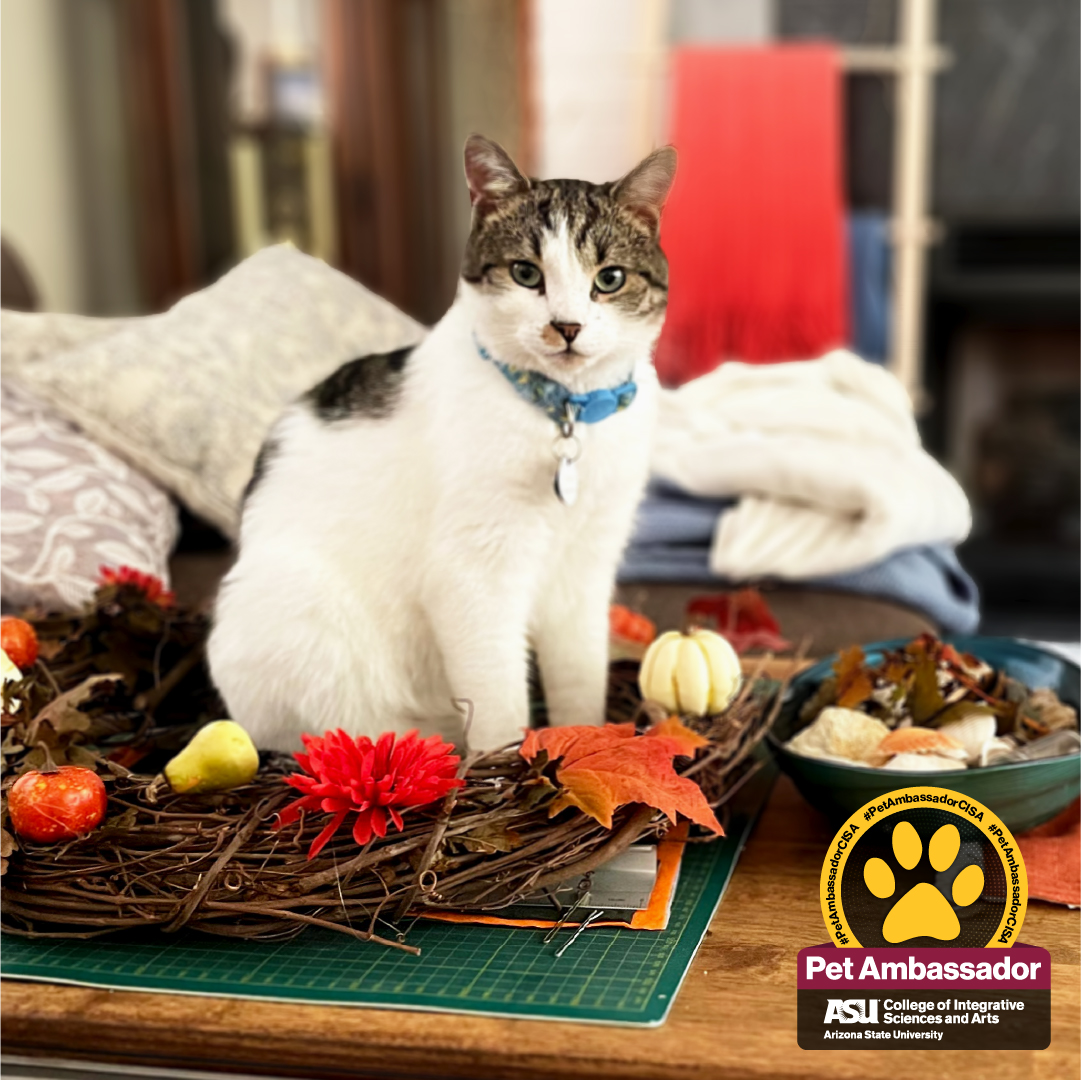
CISA Pet Ambassador Program

An Echo of the heart
Echo is a two-year-old short hair domestic cat who is also a matchmaker on the side.
On a chilly Halloween night, pre-veterinary student Karen went to a bonfire, looking to unwind and hang out with friends, But fate had another plan. As the bonfire roared, a man she never met before entered the scene carrying his new companion, Echo a very tiny barn kitten.
Karen was drawn to Echo and Echo to her and soon after meeting, Echo was fast asleep inside Karen's coat pocket.
Anthony, the mysterious man with the kitten, and Karen chatted all night and a beautiful connection was made.
From that night on, Echo, Karen and Anthony, along with Karen's 2 other domestic short hair cats, Sheila and LTDan, became a powerful tribe of five; they all knew they should be a family.
Karen and Anthony will soon be celebrating their 1st wedding anniversary and Echo will welcome a human baby brother at the end of this year.
Cat facts with Lecturer Julie Murphree
Although Echo was born in a barn, he was not fearful and shy. He definitely displayed the characteristics of a friendly cat! How did this happen?
A huge misconception surrounding cats is that they are solitary self-sufficient loners! Cats have social needs.
Unfortunately, we animal behaviorists and ethologists don't know as much about cats and their emotions as we do about other domestic animals. In addition, a lot of what we do know hasn't gotten out to the general public.
One of the most important things to realize about cats is that they haven't really been domesticated
— at least not nearly to the degree dogs have. Wolves started evolving into dogs 100,000 years ago. During domestication, early humans needed their dogs to guard their camps and help them hunt, and early dogs needed their humans for food and shelter. They depended on each other.
No one knows for sure yet when wild cats started to evolve into domestic cats, (although the oldest cat remains found in the graves of humans are 9,500 years old). The most popular theory of how cats became domestic animals is that they joined human settlements to prey on rats and mice. Cats probably haven't been changed that much by their association with people because cats and humans had a mutualistic relationship instead of the more symbiotic relationship humans and dogs had.
With people and cats, it was more of a relationship of convenience. Cats killed mice and rats (and humans provided lots of mice and rats to kill since mice and rats lived in human settlements!) The two species didn't need each other so much as profit by being around each other. The result: the house cat today is a lot closer to a wild cat than a dog is to a wolf!
Scaredy cats
Fear can be a big problem for cats, which is probably why we have the expression “scaredy cat.” A lot of house cats are so afraid of strangers that they hide anytime someone comes to visit — perhaps it’s because cats are genetically closer to their wild counterparts — it's possible cats naturally have more fear of humans than dogs do because they're not as fully domesticated.
Research has shown that cats can be divided into two personality categories: bold cats (confident, easygoing, sociable and trusting); and fearful cats (timid, nervous, shy and unfriendly.)
Boldness and friendliness go together — bold cats are faster to approach a novel object than shy cats are and are friendlier to people. So if you want a naturally friendly cat, you could consider getting a cat from a breed that's known for being friendly. (The Siamese breed is a good bet.)
Handle with care
Another way to ensure that friendly, bold personality is to get a kitten and make sure lots of people gently handle it when it's tiny! The sensitive period for socialization is from the second week of the kitten’s life to the seventh week, and the more people who handle the kitten during this time the better — this is very important because it's so easy for cats to go feral.
My great-grandma had kittens underneath her farmhouse in a spot where she couldn't find them — by the time she finally discovered where they were, the kittens were well over two months old and were super wild. She couldn't handle them. I've seen the opposite happen, too: I found a mama cat and her kittens living on the ASU Polytechnic campus in a culvert next to one of the dorms. Those kittens had been handled by so many students and were the friendliest, cutest little kittens ever!
Kittens need a lot of friendly human handling during the sensitive period. At the same time, handling won't turn a genetically shy cat into a completely friendly one.
Research has shown that shyness is inherited, and although you can reduce it you can't totally reverse it.
If you adopt a kitten from a shelter and want to pick one that is friendly: put your hand in the cage; some of them will come right up to you and rub you while others cuddle in the back. The kitty that comes right up to you is the kitty you want!
Echo chose Karen. Was it evolution? Fate? Chemistry? His bold personality allowed a mutualistic relationship that blossomed for Karen and her husband!

